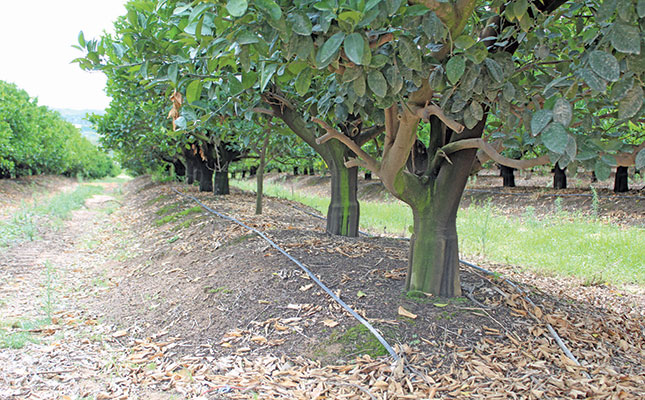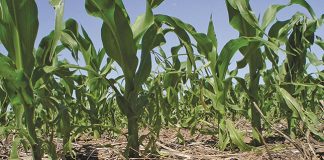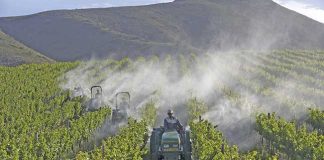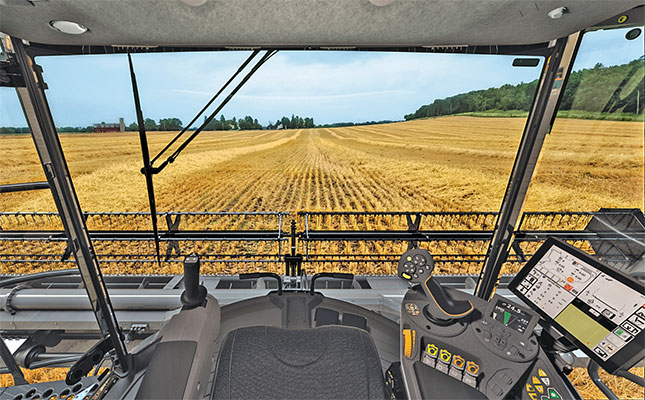
Photo: Lindi Botha
“The days of starting the pump in an orchard and assuming the trees will be watered are long gone,” says Willem Kieviet, area manager of Indigo Fruit Farming on the outskirts of Mbombela, Mpumalanga.
Instead, he uses a meticulous method in which every decision is backed up by data, and any water applications are checked and double-checked.
“You need to think about how much water you’re applying and why. Ask yourself what time of the day is best for irrigating and what the expected outcome of the irrigation is, then measure whether it was achieved. Applications that rely on technology must be followed up by people, and vice versa.”
Indigo produces mandarins and seedless lemons, and has been using drip irrigation since 1997. Kieviet prefers this method to micro-irrigation, as it uses less water.
“With micro-irrigation, there’s more evaporation because you’re wetting a bigger surface area. Also, the water penetration isn’t necessarily as deep as with drip irrigation, so you lose a portion of the water you apply. Drip irrigation is more focused on a specific area.”
As the farms have mostly sandy loam soil, drip irrigation provides a further benefit: the drippers provide a suitable flow of water to top up the moisture levels without run-off.
The irrigation system differs somewhat from orchard to orchard, as new systems have been introduced on the farms since 1997. While some orchards are planted to a single row of trees with double dripper lines, others have double rows of trees with double dripper lines.
The water flow also varies, ranging from 0,7ℓ/h to 2,3ℓ/h. The latter is used for single-row lines and provides water at a rate of 4,6m³/ha/h. The 0,7ℓ/h drippers are placed in double rows and provide 2,3m³/ha/h of water.
Slowing the flow
Kieviet says Indigo is moving towards reduced- flow irrigation. The trees still receive the same amount of water overall, but their uptake is far better with lower flow over a longer period.
Each block has a dedicated main irrigation line so that the system can be managed from the pumphouse, rather than the orchard. There are also flow and pressure meters on each line to detect problems and accurately measure what is being applied.
The entire system is automated, which enables Kieviet to view all the irrigation applications at a glance, with problem areas showing up in different colours on his computer screen.
Controlling the irrigation from the pumphouse on each farm simplifies management, as valves don’t have to be turned on and off in the orchards, which could be affected by human error.
The trees receive between 3 500m³ and 4 500m³/ ha/year of irrigation water. Citrus trees require about 6 500m³/ha/year. Rainfall in the area is about 820mm annually, which complements the scheduled irrigation, but Kieviet points out that not all rain provides effective irrigation.
“For example, it might rain softly for some time. Although this will count towards annual rainfall, it doesn’t really add much water for the trees. Conversely, storms bring a lot of water, but most of it flows away. We estimate that about 50% of the rain we receive is actually effective irrigation.”
The automated irrigation is scheduled for early mornings before it becomes too hot, as trees stop functioning and absorbing water when the temperature exceeds 35°C. The early-morning irrigation also gives the trees the water they need for photosynthesis and transpiration.
Water availability
Irrigation water is obtained through a canal system from the Primkop Dam. Kieviet says that the water quality is good, generally maintaining a pH of 7.
At certain times of the year, however, such as towards the end of winter, there are more micro-organisms in the water and it is then necessary to manage the filtration systems to prevent clogging of the pipes. Indigo uses spin clean filters for the water filtration.
Kiewiet and his team provide a continuous dose of hydrogen peroxide all-year round to keep the drippers clean. Once a year, however, just before the fertigation programme starts, they apply a booster treatment of the compound. Normal dosing continues thereafter.
Indigo has a total of 200 000m3 of water storage capacity. Keeping the dams full has been a challenge, however, especially during the drought over the past few years.
“Because our dams are not very big, and there aren’t many in the area, it’s important to get a regular flow of water into them. This means managing the canal systems properly so that we get the allocated volume of water on time.”
Checking and double-checking
Indigo takes water usage so seriously that checks and balances are in place for every system on the farms to ensure that nothing is wasted. The trees are irrigated optimally at the time they need it most, and the system is managed meticulously to prevent any system failures.
At the start of each season in July, Kieviet works out an irrigation plan based on a set formula.
“I look at the maturity of the trees, canopy coverage, and the assumed evapotranspiration every month of the year. For the last of these, we use the 10-year average as provided by weather stations on the farms. We then add the crop factor to take into account the different requirements of the fruit at different times of the year. After this, we plan exactly how much water needs to be applied in a year. This is the theoretical figure we work towards. As soon as we start implementing the irrigation schedule, we record how much was applied, where we stand in terms of the requirement, and where we’re ahead or behind.”
A flow meter fitted to every main irrigation line measures the actual water that the trees receive and enables Kiewiet and his team to monitor the water used per block.
“The entire irrigation system is automated and set to monitor the theoretical values versus the actual values, so it’s that much easier to manage and measure,” he explains. “An alarm goes off on my computer if there are any large discrepancies between theoretical and actual figures, so we can react quickly if there are leaks or other problems.
“Ultimately, we aim to avoid any excess or deficiencies. We use soil moisture probes to see how much water the tree extracts, and how much needs to be given to ensure there’s no deficit.”
The human factor
Technology is backed up by onsite observation, with one worker assigned to each 10ha block. It is these employees’ responsibility to walk through the orchards daily to check for any problems.
Soil observations are carried out once a week and compared with the data on the computer system’s graphs. Samples are taken at different depths and then scored from one to five, according to the level of moisture in the soil. Kieviet aims for a score of three to four, with five being very wet and one being very dry.
“If I see a correlation between this physical assessment and that of the probes, I can assume everything is running as it should with the irrigation. The next step is to walk through the orchard to see whether the condition of the trees correlates with everything else.
“For example, the formula we have for irrigation, as determined at the beginning of the season, could prescribe that we need 17 hours of irrigation to get the desired growth. But when we add the results from the soil moisture probes, it may show that there’s [plenty of] moisture in the soil already. We then update the irrigation cycle accordingly to prevent the trees from being overwatered.”
Kieviet also pays attention to the electrical conductivity (EC), taking daily measurements in the orchards to verify the figures provided by measurements in the pumphouse.
“We have a container below a dripper in the orchard and measure how much water has been applied by that dripper, and the EC and pH of the water. We want an EC of between 1,6 and 2. So we have the theoretical information from the pumps, and what’s actually being applied.”
The pressure provided by the system is an important factor in ensuring an even flow of water throughout the orchards. At least one bar of pressure is needed in the dripper lines, and water should reach all the pipes within five minutes of the irrigation starting. If it takes any longer, the farthest end of the line will always receive less water, as the water takes longest to reach that area, and the water flow there will also stop first when the system is turned off.
Pressure in the orchards is measured using a hand-held meter, and there is also a meter in the pumphouse. Again, what is shown in the pumphouse is verified in the orchards.
The gradient of the orchards is also a factor that must be considered when designing an irrigation system. Kieviet stresses that the design is the starting point of an effective
system; it must ensure that the correct surface area can be irrigated without fluctuations in water supply.
“Dripper lines must not be over 200m in length, otherwise you struggle to get enough water flow through the entire pipe.”
Key irrigation periods
Kieviet pays special attention to certain periods throughout the year to ensure that each tree performs optimally.
“The period between harvest completion and fruit set for the next season occurs at
a critical time, and the irrigation must be managed carefully during this period.
“The humidity is low at this time of the year and the summer rain has yet to arrive. So we need to irrigate according to the phenological needs of the trees; this will ensure good flowering and fruit set.
“The next period that’s important to manage is February to March, when internal fruit quality needs to be prioritised and water is then reduced.
“Too much water at the beginning of the year can reduce the Brix figures [the levels of sugars and other compounds in fruit].
“During [harvesting], it’s important to continue irrigating so that the fruit doesn’t get too soft.
“But you can’t have too little water either, or the fruit will develop rind breakdown due to the lack of moisture. May is flower- initiation time, and the tree needs to have enough water to see this process through.”
It is crucial at these stages to monitor the probes and compare the planned irrigation against what the trees are receiving and absorbing.
“When we look at the soil moisture content on a graph, we want to see ups and downs; there need to be wetter times and drier times. This is so that the soil and roots have time to aerate and take up oxygen.”
While using the least amount of water to obtain a good yield, the management of Indigo is observing the water it takes to produce a kilogram of fruit and hoping to make changes in future.
“We’ve seen that since the cultivars vary in yield from year to year, while the amount of irrigation would remain the same, we’re effectively using more water to produce a smaller yield in the off year. We’ve started measuring the amount of water used annually per kilogram of fruit obtained, so we can [ultimately] eliminate big variations in the litres of water used to produce a kilogram of fruit. We want to obtain a set yield, with a set quality, using a set amount of water. With water resources increasingly under pressure, we need to ensure our long-term sustainability. And that means watching every drop and managing it correctly.”
Email Charlene Nieuwoudt at [email protected].










